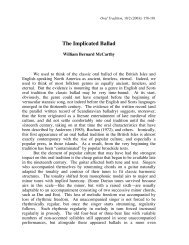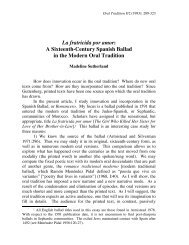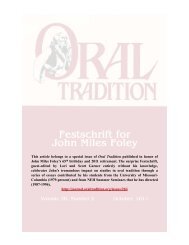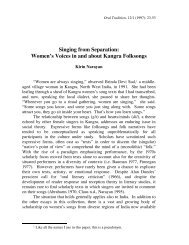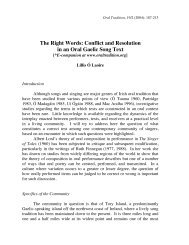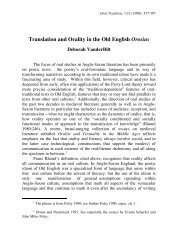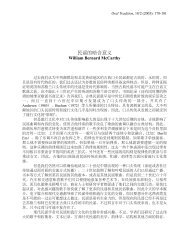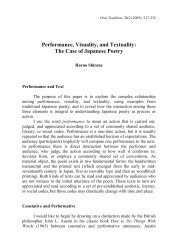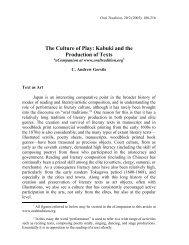Writing as Relic - Oral Tradition Journal
Writing as Relic - Oral Tradition Journal
Writing as Relic - Oral Tradition Journal
You also want an ePaper? Increase the reach of your titles
YUMPU automatically turns print PDFs into web optimized ePapers that Google loves.
<strong>Oral</strong> <strong>Tradition</strong>, 14/2 (1999): 430-446<br />
<strong>Writing</strong> <strong>as</strong> <strong>Relic</strong>:<br />
The Use of <strong>Oral</strong> Discourse to Interpret Written Texts<br />
in the Old French La Queste del Saint Graal<br />
Lisa Robeson<br />
Many well-known critics of the thirteenth-century French romance<br />
La Queste del Saint Graal 1 have noted that the Queste author transformed<br />
the nature of Arthurian adventure. Scholars such <strong>as</strong> Pauphilet, Matar<strong>as</strong>so,<br />
Todorov, Poirions, and de Looze have argued that success in the quest of<br />
the Holy Grail depends on correct interpretation of signs and symbols that<br />
the knights encounter on their path, and not on military valor. 2<br />
Interpretation of this new code requires that the knights substitute spiritual<br />
signifieds for the things that they see and hear, including the many<br />
inscriptions they read, for the traditional meanings that affirm the values of<br />
conventional chivalry: love, honor, prouesse, and material gain. 3 Only the<br />
knights who are irredeemably worldly, such <strong>as</strong> Gawain and Hector, engage<br />
in typical Arthurian adventures and combats. The three chosen knights who<br />
eventually find the Grail—Galahad, Perceval, and Bors—are without<br />
peer in understanding spiritual interpretations.<br />
1 The thirteenth-century French romance La Queste del Saint Graal, or The Quest<br />
of the Holy Grail, is the second of the first three Arthurian romances that comprise the<br />
Vulgate Cycle. Probably composed by different authors, the stories of Lancelot (Lancelot<br />
en prose), and the narrative of the downfall of the Round Table (Le Marte Artu) delineate<br />
the rise and fall of the Arthurian kingdom of Logres. Written by an anonymous author,<br />
probably a cleric, perhaps a Cistercian, around 1220-25, the romance attempted to<br />
redirect chivalry toward spiritual goals. Adventures on the quest often require the knights<br />
to read rather than to fight, and their goal is a religious object: the Holy Grail (in this<br />
narrative, the cup of the L<strong>as</strong>t Supper).<br />
2<br />
See Pauphilet 1921:157-58; Matar<strong>as</strong>so 1979:11; Todorov 1971:137; Poirion<br />
1994:204; de Looze 1985:131.<br />
3 For more on the transformation of Arthurian romance in the thirteenth century,<br />
see Poirion 1976; Frappier 1976b; Hanning 1985.
WRITING AS RELIC IN OLD FRENCH ROMANCE 431<br />
Given the focus on interpretation in the romance, the written texts<br />
that the knights encounter on their adventures are of critical importance in<br />
achieving their goal. In this essay, I would like first to argue that the<br />
inscriptions that appear on stone monuments, crosses, and other durable<br />
surfaces share the characteristics of saints’ relics; second, that the oral<br />
interpretations of these written texts, which are presented by a host of<br />
hermits, anchoresses, and other holy people, validate the inscriptions in the<br />
same way that oral hagiographies and eyewitness accounts of miracles<br />
supported the authentication of relics; and finally that the texts in the<br />
Queste that are not inscribed, but rather written down on parchment, are<br />
analogous to the documentary evidence necessary to validate the<br />
authenticity of relics after the twelfth century.<br />
Jean Frappier and Pauline Matar<strong>as</strong>so have contended that the Holy<br />
Grail itself operates <strong>as</strong> a saint’s relic in the Queste. 4 However, the<br />
monumental inscriptions that appear in the romance also share<br />
characteristics with relics, since both serve <strong>as</strong> links between earth and<br />
heaven. <strong>Relic</strong>s, or the physical remains of saints, were thought to retain the<br />
power of what Peter Brown h<strong>as</strong> called “the holy dead.” 5 A saint’s body<br />
retained the saint’s holiness in praesentia, the sacred physically manifested.<br />
The relic is a point of contact between the divine and the temporal that may<br />
serve <strong>as</strong> a conduit for God’s grace. Even after the early Christian period<br />
when the practice of veneration began, the inseparability of soul and body<br />
even after death remained a b<strong>as</strong>ic premise of veneration. 6<br />
Inscriptions in the Queste are obviously not the remains of human<br />
bodies, however holy. On the other hand, there is some evidence in the text<br />
suggesting that they are loci of praesentia, points at which the divine is<br />
physically made manifest and available to human beings. In the Queste,<br />
inscriptions are not “channels of grace,” <strong>as</strong> one theologian in late antiquity<br />
termed relics, 7 but conduits for the Holy Spirit. The Spirit, which plays an<br />
important role <strong>as</strong> a source and an end of the quest for the Holy Grail in this<br />
romance, moves through these inscriptions because it is the author, or at<br />
4 Frappier 1976a:557; Matar<strong>as</strong>so 1979: 182.<br />
5 1981: 10. Brown provides a clear summary of the influence of Christianity on<br />
pagan attitudes toward the bodies of the dead and the rise of the cult of saints in the late<br />
antique world. For more on the cult of the saints in the later Middle Ages, see Herrmann-<br />
M<strong>as</strong>card 1975 and Geary 1990. For a complete bibliography to date, see Wilson 1983.<br />
6 Brown 1981:88,6-10; Bynum 1991:76-77.<br />
7 Vitricius, De Laude Sanctorum, cited in Kemp 1948:4-5.
432 LISA ROBESON<br />
le<strong>as</strong>t the scriptor, of the mysterious inscriptions that prompt many of the<br />
knights’ adventures. 8<br />
For example, events in the first episodes of the romance suggest a<br />
direct relationship between the presence of inscriptions and the Holy Spirit.<br />
The romance opens <strong>as</strong> Bors, Lionel, and Lancelot read texts incised on the<br />
stone chairs that surround the Round Table. Each chair bears an inscription<br />
that says, “Here shall sit this or that one.” 9 On the Sieges Perilous, however,<br />
the inscribed letters trace a different message: “454 years have p<strong>as</strong>sed since<br />
the p<strong>as</strong>sion of our Lord Jesus Christ; and on the day of Pentecost, this seat<br />
shall find its m<strong>as</strong>ter.” 10 The knights do not understand the inscription, but it<br />
inspires such a feeling of awe in them that they decide to cover it with a<br />
veil. When Galahad arrives the next day, which is Pentecost, the knights lift<br />
the veil and find that the inscription h<strong>as</strong> changed to “This is the seat of<br />
GALAHAD.” 11 To the knights, these words look “newly made”<br />
(nouvelement fete; idem). In other words, it seems <strong>as</strong> if the text h<strong>as</strong> been<br />
supernaturally edited while the inscription w<strong>as</strong> covered.<br />
A topos of medieval exegesis suggests that this editor may have been<br />
the Holy Spirit. Commentaries often stated that the Scriptures were written<br />
“by the finger of God,” a metaphor for the Holy Spirit. 12 The metaphor<br />
8 Lancelot, for example, is told by a holy man that” ... the Holy Grail is the grace<br />
of the Holy Spirit” ( ... ce est Ii Sainz Graax, ce est la grace del Saint Esperit) in<br />
Queste:159. All quotations from the Queste are taken from Pauphilet’s 1984 edition,<br />
hereafter Queste; all translations are my own unless otherwise noted. For important<br />
discussions on the role of the Holy Spirit in the initiation of the quest and the symbolism<br />
of the Holy Grail, see Matar<strong>as</strong>so 1979:180-204 and Lot-Borodine 1951.<br />
9 “Cl DOIT SEOIR CIL” (Queste:4).<br />
10 “ ... CCCC. ANZ ET .LIIII. SONT ACCOMPLI EMPRÉS LA PASSION<br />
JHESUCRIST; ET AU JOR DE LA PENTECOUSTE DOIT CIST SIEGES TROVER<br />
SON MESTRE” (4).<br />
11 “CI EST LI SIEGES GALAAD” (8).<br />
12 The following p<strong>as</strong>sages, drawn from authors writing between the eighth and<br />
twelfth centuries, show consistent use of the figure “finger of God” to indicate the Holy<br />
Spirit: Ambrosius Autpertus, Expositio in Apocalypsin: “Que propterea arca testamenti<br />
vocatus, quia duorum in ea Testamentorum virtus digito Dei, hoc est, Spiritus Sancto<br />
inscribitus, non iam in tabu lis lapideis, sed in tabulis cordis carnalibus” (CCCM, 27:441);<br />
Walter of St. Victor, Sermones: “Utrumque scriptum est in digito Dei, id est Spiritu Dei<br />
Sancti ... “ (Sermo 3, CCCM, 30:26); William of St. Thierry, Expositio super Epistolam ad<br />
Romanos: “Scilicet que legis sunt, in tabulis scribuntur vel chartulis, quae vero sunt<br />
gratiae, digito Dei, id est Spiritu Sancto mentibus nostris inscribuntur” (CCCM, 86:58);
WRITING AS RELIC IN OLD FRENCH ROMANCE 433<br />
may have been suggested by the account of the giving of the Law in<br />
Deuteronomy. In this version, Moses says, “And the Lord gave me two<br />
stone tablets written with the finger of God and containing all the words<br />
that have been spoken to you in the mountain in the middle of the fire . . . ”<br />
(Deut. 9: 10). 13 Furthermore, in the Exodus account of the giving of the<br />
Ten Commandments, Moses puts a veil over his face after he h<strong>as</strong> spoken to<br />
the Lord on the mountain, just <strong>as</strong> the knights veil the inscription on the<br />
Sieges Perilous after reading it (Ex. 34:33-35). In On the Letter and the<br />
Spirit, St. Augustine connects the inscription of the Law with the coming of<br />
the Holy Spirit at the first Pentecost. He writes that the crowd of apostles<br />
and people gathered in Jerusalem were like those Jews who waited at the<br />
foot of Sinai for Moses; only there, at Sinai, the finger of God (digitus Dei)<br />
worked in stone tablets, but at Pentecost it wrote in the hearts of men. 14<br />
Finally, the first inscriptions are read on the day before Pentecost and the<br />
search for the Holy Grail begins on the day of the fe<strong>as</strong>t, which<br />
commemorates the coming of the Holy Spirit. 15<br />
Johannes Belethus, Summa de Ecclesi<strong>as</strong>ticis Officiis: “Sed Spiritus Sanctus datus est<br />
centumviginti discipulis in corde digito Dei spiritualem intelligentiam intus eis dictante”<br />
(CCCM, 41A:247); John of Ford, Super Extremam Partem Cantici Canticorum Sermones<br />
CXX: “Meum erit ex munere tuo, vocum aliqu<strong>as</strong> significationes verbo vel scripto exhibere:<br />
tuum vero digito Dei, qui est Spiritus Sanctus, ea quae significantus inscribere” (CCCM,<br />
17:34-35); Peter Abelard, Commentaria in Epistulam Pauli ad Romanos: “Probat quod<br />
dixerat, legem videlicet Moysi bonam esse, licet occ<strong>as</strong>ionem inde in peccatum acceperit,<br />
quia videlicet est spiritualis lex, non saecularis, tamquam dig ito Dei scripta, id est Spiritu<br />
Sancto . . .” (CCCM, 11:205); Rupert of Deutz, De Sancta Trinitate et Operibus Eis:<br />
“Igitur legis et gratiae summa secundum numerum consonantia est, quia videlicet a<br />
p<strong>as</strong>chali vespera quinquagesimo die, lex in tabulis lapideis digito Dei scripta per Moysen<br />
data est; gratia autem et verit<strong>as</strong> per Iesum Christum facta est, quinquagesimo nihilominus a<br />
ressurectione eius die Spirito sancto misso de caelo in cordibus apostolorum scripta est”<br />
(CCCM, 22:715); Hildegard of Bingen, Scivi<strong>as</strong>: “ . . . quia idem Filius in sapientissima<br />
Virgine, quam aurora significat, incarnatus est inspiratione digiti Dei qui Spiritus Sanctus .<br />
. .” (CCCM, 43A:338).<br />
13 “Deditque mihi Dominus du<strong>as</strong> tabul<strong>as</strong> lapide<strong>as</strong> script<strong>as</strong> digito Dei et continentes<br />
omnia verba, que vobis locutus est in monte de medio ignis. . . .” Quotations from the<br />
Vulgate are taken from Biblia Sacra.<br />
14<br />
“. . . ibi in tabulis lapideis digitus dei operatus est, hic in cordibus hominum”<br />
(CSEL, 60: 182).<br />
15 For more on the many parallels that the Queste author draws between the<br />
gathering of the knights of the Round Table after Galahad arrives at court and the<br />
appearance of the Holy Spirit on the day of Pentecost, see Matar<strong>as</strong>so 1969:286.
434 LISA ROBESON<br />
Saints’ remains designated <strong>as</strong> relics also produced miracles. In the<br />
Queste, monumental inscriptions do not cause the spontaneous healing or<br />
alterations to the body so common in twelfth- or thirteenth-century<br />
accounts of miracles, but they do serve <strong>as</strong> a conduit for miraculous<br />
revelation. 16 The messages of the inscriptions are not directions to find the<br />
Holy Grail; rather, they often contain references to history or prophecy.<br />
These references are usually explicated in oral discourses by local hermits<br />
or anchoresses. It is from these spoken explanations that the three Grail<br />
knights receive an understanding of what they see, hear, and experience;<br />
gradually, over the course of the narrative, Arthur’s knights receive a fuller<br />
understanding of the history of the Grail and its relation to the Arthurian<br />
court. For example, in an episode in which Lancelot discovers an<br />
inscription on a stone cross, the nearby hermit who helps him understand<br />
his discovery recounts the long and detailed story of Joseph of Arimathea<br />
and the Grail in which Joseph’s descendants bring the cup of the L<strong>as</strong>t<br />
Supper to Arthur’s realm of Logres. 17 Lancelot cannot read the letters on<br />
the cross because he h<strong>as</strong> not yet confessed his sin with Guenevere, but the<br />
encounter with his inscription begins an adventure during which the story<br />
of Joseph is told.<br />
More significant still are the historical accounts that are presented to<br />
the knights in response to inscriptions that appear on the Ship of Faith, a<br />
large ship built by Solomon that will take the three knights who have been<br />
chosen to see the Grail to the l<strong>as</strong>t leg of their journey. The ship, which h<strong>as</strong><br />
no m<strong>as</strong>ter and moves of its own accord, is filled with inscribed surfaces,<br />
including its hull, the scabbard of a sword, a cloth covering the sword, and<br />
both sides of the blade of the sword. Perceval’s sister, who is their guide on<br />
this portion of the journey, provides oral explanations of the inscriptions<br />
that reveal that Galahad is descended from the Maimed King of Arthurian<br />
legend; she also discusses what role the Grail of the apocryphal Gospel of<br />
Nicodemus plays in the history of the Maimed King’s descendants. She<br />
explains that the inscription on the scabbard is the story of the Maimed<br />
16 On the nature of miracles effected by relics in accounts of the twelfth and<br />
thirteenth centuries, see Bynum 1991:70-72.<br />
17 Robert de Boron’s early thirteenth-century romance Joseph d’Arimathie w<strong>as</strong><br />
probably the first Arthurian narrative to conflate the platter or stone of Celtic tradition<br />
and the cup of the L<strong>as</strong>t Supper. The story of the transportation of the cup from the Holy<br />
Land to Logres by Joseph’s family appears in the apocryphal Gospel of Nicodemus; see<br />
Robert de Boron.
WRITING AS RELIC IN OLD FRENCH ROMANCE 435<br />
King and his descendants at Arthur’s court (204-5). 18 Furthermore, when<br />
the knights read the text on the blade of the same sword, they receive an<br />
expansion of both histories and their connections (206-10). In other words,<br />
Galahad, Perceval, and Bors, the three Grail knights, obtain a history of the<br />
18 History in the Queste is a complicated and une<strong>as</strong>y blend of Biblical narrative,<br />
apocryphal tradition, and Celtic legend. There are no fewer than five major dispositions<br />
on the history that culminates in the arrival of Galahad at Arthur’s court and the<br />
beginning of the quest of the Holy Grail. The first, related to Galahad at the abbey where<br />
he receives his shield, recounts the departure of Joseph of Arimathea from the Holy Land,<br />
his arrival in the pagan city of Sarr<strong>as</strong> ruled by King Evalach and his brother-in-law<br />
N<strong>as</strong>cien, and his conversion of both men to Christianity. The abbot also explains to<br />
Galahad that Joseph and his son Josephus left Sarr<strong>as</strong> to come to Britain, accompanied by<br />
Mordrains (the baptismal name of Evalach) and N<strong>as</strong>cien; Galahad is descended from<br />
N<strong>as</strong>cien (32-35). The second important discourse on the history of the Queste world is<br />
given to Lancelot when a hermit explains the meaning of one of his visions. Lancelot sees<br />
the Grail moving toward a wounded King. The hermit reveals that the king is Mordrains.<br />
Lancelot is a descendant of N<strong>as</strong>cien (<strong>as</strong> is, of course, Galahad), and Galahad’s mother is<br />
the daughter of the Fisher King: thus Galahad’ s history combines both the apocryphal<br />
and Arthurian traditions (134-38). A third disposition is recounted to Percival by his aunt,<br />
a holy woman. It is she who explains the underlying schema of the history to Logres.<br />
Major er<strong>as</strong> are marked by three great tables. The first table is that of the Lord’s Supper;<br />
the second is the table of the Holy Grail, which supplied Joseph and Josephus with food<br />
when nothing could be found to eat. The third era of history is <strong>as</strong>sociated with the Round<br />
Table, established to bring chivalric Christendom together in order that they might<br />
undertake the Quest of the Holy Grail (74-79). The connections between biblical and<br />
apocryphal history and Celtic legend are further elaborated by Perceval’s sister on the<br />
Ship of Faith. First, she explains the origin of the W<strong>as</strong>te Land. King Lambar, the father of<br />
the Maimed King, met and converted the pagan King Varian in Logres near the Ship of<br />
Faith. Varian killed Lambar with a sword; this murder, the first ever committed in<br />
Logres, laid the land w<strong>as</strong>te (204-5). Her second narrative explains how Mordrains w<strong>as</strong><br />
wounded. His brother-in-law N<strong>as</strong>cien undertook a quest in a distant land, returned after<br />
great peril and rejoined Mordrains, bringing a miraculous sword that saved him. Despite<br />
a warning on the sword, Mordrains draws it and is instantly struck down <strong>as</strong> the sword<br />
breaks in two (206-8). Her final narrative sketches the connection between the lineage of<br />
Mordrains and N<strong>as</strong>cien, and that of the Maimed King and of the Fisher King. King<br />
Parlan, the Maimed King, w<strong>as</strong> hunting in the forest when he came upon the mysterious<br />
Ship of Faith. Despite the warnings on the ship and the scabbard, Parlan enters the vessel<br />
and draws his sword. He is instantly pierced through the thighs with a lance. Perceval’s<br />
sister tells him that the wound will remain unhealed until Galahad arrives at his seat, the<br />
C<strong>as</strong>tle of Corbenic (209-10). At Corbenic it is revealed that King Parlan is the father of<br />
the Fisher King, Galahad’s grandfather (259). Therefore, Galahad is descended from both<br />
N<strong>as</strong>cien and the Maimed King, neatly unifying history from the apocryphal tradition and<br />
the distant p<strong>as</strong>t of the Celtic story. Finally, a letter left by Solomon provides the history of<br />
the Ship, which w<strong>as</strong> built from the Tree of Life in the Garden; it summarizes biblical<br />
events from the Fall to the construction of the boat by Solomon (210-26).
436 LISA ROBESON<br />
Grail and its connections to their own culture and colleagues. They receive<br />
the religious and historical context of their individual adventures <strong>as</strong> well <strong>as</strong><br />
an explanation of the purpose of the court and its role in history. Through<br />
the divulgence of the sacred and legendary histories of Logres and the<br />
Grail, they are able to transcend the limits of normal human understanding.<br />
Such revelation is not a miracle in the same sense <strong>as</strong> those produced<br />
by relics, that is, a miracle that produces an effect against the laws of<br />
nature. In the Queste, however, inscriptions do generate at le<strong>as</strong>t one miracle<br />
of this type: they allow the Grail knights to transcend the normal sequence<br />
of time. When Galahad, Perceval, and Bors have completed their separate<br />
adventures, they reunite and enter the magical ship that does not have a<br />
pilot or crew. With Perceval’s sister <strong>as</strong> interpreter, they read the<br />
inscriptions that contain prophecies on the scabbard and blade of the sword.<br />
The prophecies are unusual because what they predict h<strong>as</strong> already occurred.<br />
For example, the writing on one side of the blade warns that anyone who<br />
unsheathes it—except he who is bolder than any other—is foredoomed to<br />
death; the inscription adds that this will occur only one time. 19 However,<br />
Perceval’s sister reveals that the event referred to h<strong>as</strong> already occurred<br />
(204-5). In other words, the knights decode the prophecy after it h<strong>as</strong> been<br />
fulfilled. In the same way, the inscription on the sword’s scabbard foretells<br />
the unf<strong>as</strong>tening of the old swordbelt and its replacement by one made by a<br />
virgin who is the daughter of a king and queen (205-6). Perceval’s sister<br />
discloses that she is the maiden designated by the prophecy and that she h<strong>as</strong><br />
already made the belt (227). Finally, the inscription on the other side of the<br />
sword blade states that it will be most treacherous to the one to whom it<br />
should bring most honor, and that this event would happen only once (206).<br />
When Perceval <strong>as</strong>ks about that prophecy, his sister replies, “Good brother,<br />
both these things have already occurred.” 20<br />
At the beginning of the romance, all of the inscribed prophecies are<br />
read first and fulfilled later; for example, the first inscription on the Sieges<br />
Perilous says “ . . . and on the day of Pentecost, this seat shall find its<br />
m<strong>as</strong>ter,” and Galahad appears the next day. On the strange ship inscribed “I<br />
am Faith,” the expected sequence of events is reversed. It is <strong>as</strong> if the Grail<br />
knights and Perceval’s sister have somehow outdistanced normal<br />
19 “ET cESTE CHOSE A JA ESTE ESPROVEE AUCUNE FOIZ” (203).<br />
20 “Biax freres ... ces deus choses sont ja avenues” (206).
WRITING AS RELIC IN OLD FRENCH ROMANCE 437<br />
chronology and are in p<strong>as</strong>sage on a ship that moves at high speed through<br />
time <strong>as</strong> well <strong>as</strong> space. 21<br />
The inscriptions in the Queste, then, function like saints’ relics.<br />
<strong>Relic</strong>s are created because the Holy Spirit is present in a saint’s body, even<br />
after that body is dead; these bodies enable miracles to occur. In the<br />
Queste, on stone monuments and other hard surfaces, the Holy Spirit<br />
codifies written texts whose messages ultimately open a door to a<br />
revelation not permitted to any other than the select Grail knights. The<br />
inscriptions are a means of transcendence first of the normal parameters of<br />
human understanding and second of time itself.<br />
Not any physical remain can become a relic, however, and not every<br />
written text in the Queste is a portal to transcendence. <strong>Relic</strong>s had to be<br />
substantiated by testimony, either of the saint’s life or of the miracles<br />
produced by his or her remains, or preferably by both, before they were<br />
accepted <strong>as</strong> authentic by the Church. Both oral and written discourses were<br />
acceptable <strong>as</strong> validation. However, these were both subject to credulity and<br />
charlatanism. In the most famous critique of the validation of relics, On the<br />
Saints and their <strong>Relic</strong>s, Guibert of Nogent presses for more rigorous<br />
evaluation of the reliability of both oral and written hagiographies and<br />
accounts of miracles. 22 He recognizes that relics are often too e<strong>as</strong>ily<br />
accepted because prelates want the prestige, donations, business, and<br />
pilgrimage that relics bring to a site. 23 First, sources should be examined.<br />
Guibert is a lawyer who demands reliable evidence for claims to stop<br />
abuse. He cites, for example, the story of Saint Pyro in Brittany whose<br />
legend glorified him <strong>as</strong> a martyr. When Guibert inquired personally into the<br />
circumstances of the man’s death, interviewing those who knew him, he<br />
21 Burns (1985:74-77) h<strong>as</strong> also noted the knight’s transcendence of chronological<br />
time after they enter the Ship of Faith. She argues that the Queste does not present a<br />
series of allegories and interpretations, “but a text that says the same thing over and over<br />
in a slightly different form, rec<strong>as</strong>ting itself constantly in a series of analogical molds”<br />
(77). Continual repetition of the histories and adventures in the narrative constitute a<br />
series of attempts to create a full explanation of the human p<strong>as</strong>t and future; these<br />
repetitions are an attempt to recreate “a p<strong>as</strong>t that can only be recaptured through textual<br />
re-enactment” (148). Certainly the knights do receive the information that fills “gaps” in<br />
the mysteries of the Grail. However, one may also see the reception of this information <strong>as</strong><br />
part of an initiation ritual that the knights undergo on the Ship of Faith.<br />
22 CCCM, 127: 79-175. I am indebted to Dr. Thom<strong>as</strong> Head for providing me with<br />
a draft of his new translation of Guibert’s On the Saints and Their <strong>Relic</strong>s (Head<br />
forthcoming).<br />
23 CCcM, 127:103-4.
438 LISA ROBESON<br />
found that Pyro had actually gotten staggeringly drunk and fallen down a<br />
well. 24 Unconfirmed or unexamined testimony should not be accepted.<br />
Furthermore, testimony should include certain information. Guibert says<br />
that it is a “sacrilege” (prophanum) to accept <strong>as</strong> a saint one of whose times,<br />
birth, life, and time and manner of death are uncertain or ambiguous. 25<br />
Dependable information of this sort should be available in order to validate<br />
a relic.<br />
Brian Stock points out that Guibert does not completely discount the<br />
validity of oral sources, but <strong>as</strong>ks that they be substantiated, <strong>as</strong> Guibert<br />
himself investigated the stories related about St. Pyro. 26 However, his<br />
treatise does imply certain criteria for oral sources. For example, oral<br />
tradition is more reliable if it is presented by an eyewitness or by a person<br />
who received the account from an eyewitness. The information about a<br />
saint’s life he recommends—historical times, birth, life, and the time and<br />
manner of death—is not reliable if it does not use information that h<strong>as</strong> been<br />
retained in the memory of the living (nullius viventis memoria resident). 27<br />
This requirement is paralleled by the English preference for testimony that<br />
is “time out of mind,” within the memory of the oldest living person,<br />
usually a period of one hundred years. 28<br />
Also, Guibert’s treatise reflects the bi<strong>as</strong> of a highly literate reader. He<br />
seems to prefer that trustworthy written documentation support oral<br />
24 CCCM, 127:88.<br />
25 “Illud dicere audebo prophanum, quod ararum pone sacraria altissimos<br />
tribunalium instar thronos obtinent, quorum tempus, natalis ac vita, dies quoque et<br />
qualit<strong>as</strong> mortium in nullis viventis memoria resident” (CCCM, 127:89).<br />
26 Stock 1983:244. Guibert (CCCM, 127:87) recommends the support of ancient<br />
tradition (vetustatis) and truthful written accounts (scriptorum veracium traditio).<br />
27 CCCM, 127:89; The fact that testimony came from an eyewitness w<strong>as</strong><br />
important in the Middle Ages. According to Isidore of Seville (1:41), history is the<br />
narrative of deeds that have happened in the p<strong>as</strong>t; among the ancients no one composed<br />
history unless he w<strong>as</strong> present and saw the things that were later written about (Historia<br />
est narratio rei gestae, per quam ea, quae in praeteritio facta sunt, din<strong>as</strong>cuntur. . . . Apud<br />
veteres enim meno conscribetat historiam, nisi isque interfuisset, et ea quae conscribenda<br />
essent vidisset) (1:41). Authorship by an eyewitness is important because things that are<br />
seen are things that are made known without falsehood (Quae enim videntus, sine<br />
mendacio proferuntur) (1:41). Jeanette Beer points out (1981:10) that Isidore falsely<br />
attributes the etymology of historia to the Greek words meaning “to know” and “to see.”<br />
28 According to Clanchy (1993: 152), “time out of mind” referred to “the earliest<br />
times that could be remembered by the oldest living persons.”
WRITING AS RELIC IN OLD FRENCH ROMANCE 439<br />
testimony. How can a community, he <strong>as</strong>ks, “take <strong>as</strong> their patron someone<br />
about whom they know almost nothing because they can discover nothing<br />
written about him except for his name?” 29 In these c<strong>as</strong>es, <strong>as</strong> Guibert says,<br />
“the clergy remains silent while any old wife or flocks of worthless little<br />
women chant fabricated stories about such patrons while at work on their<br />
treadles and looms.” 30 Finally, both oral and written texts supporting the<br />
claims of relics should conform to the stylistic aesthetics of literary<br />
tradition. Guibert reminds his readers that Augustine discounted the<br />
authenticity of the Gospel of Thom<strong>as</strong> in part because of its style, which<br />
created a strepitus aurium, a rattling or clattering in the ears. 31 If the style<br />
of an account, even a written one, is ragged (pannoso), pedestrian<br />
(pedestri), serpentine (humi serpente eloquio proferuntur), and confused<br />
(inconditissime delatrantur), it will be believed to be false even if it is<br />
true. 32 In other words, the style of any source should lack the repetition that<br />
creates a rattling in one’s ears, follow a logical and not a winding order, and<br />
should not sound pedestrian or vulgar. These, of course, tend to be<br />
standards created by literate culture and not by oral tradition.<br />
Looking at the inscriptions in the Queste, probably composed about<br />
one hundred years after On the <strong>Relic</strong>s of the Saints, in light of Guibert’s<br />
recommendations for evaluating the authenticity of relics, one sees that the<br />
oral discourses used to support and explain the inscriptions follow<br />
Guibert’s principles for good attestation. 33 For example, these discourses<br />
maintain a literate style and organization in that they mimic written biblical<br />
commentary. 34 Matar<strong>as</strong>so, for example, argues that these commentaries<br />
29 CCCM, 127:100: “Decant ergo michi quomo sibi illum patrocinari estimant, de<br />
quo quicquid est sciendum ignorant; nusquam de eo scriptum preter nomen invenies.”<br />
30 CCCM, 127:100: “Ceterum tacente clero anus et muliercu1um vilium greges<br />
talium patronorum commentat<strong>as</strong> histori<strong>as</strong> post insubulos et 1itatatoria cantitant. . . .”<br />
31 CCCM, 127:87.<br />
32 CCCM, 127:87.<br />
33 Huygens dates De Sanctis et eorum Pigneribus between 1114 and 1120<br />
(CCCM, 127:32). Pauphilet (1921:12) <strong>as</strong>signs 1220 <strong>as</strong> an approximate date for the<br />
composition of the Queste; Matar<strong>as</strong>so (1969:25) suggests a time between 1215 and 1230.<br />
34 Many critics have argued that the Queste’s narrative structure and interpretive<br />
episodes reflect biblical models, either gospel texts or exegeses. Locke (1960:25-33)<br />
considers the central model of the narrative to be Holy Scripture. Strubel (1989:44) <strong>as</strong>serts<br />
that the interpretive episodes function <strong>as</strong> “une glose permanente.” Baumgartner (1981:44)<br />
writes that the Queste is “un nouvel evangile pour cette nouvelle race de chevaliers”
440 LISA ROBESON<br />
follow a pattern of threefold biblical exegesis, certainly a structure<br />
developed from the literate establishment and not from folk tradition<br />
(Matar<strong>as</strong>so 1979:11). Furthermore, these oral discourses are often delivered<br />
by an eyewitness. Perceval’s sister, for example, is reporting her own<br />
experience when she reveals that she h<strong>as</strong> made the swordbelt that will<br />
replace the one found on the Ship of Faith (227), and an inscription on the<br />
forehead of Josephus, the son of Joseph of Arimathea, testifies to his<br />
identity and the reliability of the history of the Grail (268).<br />
Even better, however, are oral accounts that are supported with<br />
reliable written documentation. Three written texts that are not inscriptions<br />
are encountered in the work. Two of these are letters, one written by the<br />
biblical character Solomon and read by the knights who discover it on the<br />
Ship of Faith; the other is a letter written by Perceval about his sister’s<br />
death. Perceval places the letter under her body on the Ship of Faith, where<br />
it is discovered and read by Lancelot. The final manuscript text appearing<br />
in the work is the text of the romance itself.<br />
First, the letter written by Solomon expands the explanation of the<br />
history presented to the elect knights <strong>as</strong> part of their encounter with<br />
inscriptions. The letter recounts the story of the Tree of Life, the tree from<br />
which Eve picked the apple. When she is expelled from Eden with Adam,<br />
she takes a twig from the tree with her and replants it. Eventually, the twig<br />
becomes the tree under which Cain kills Abel. In conformity with medieval<br />
tradition, the tree will become the source of the wood of Christ’s cross, but<br />
<strong>as</strong> an Old Testament character Solomon does not know this and merely says<br />
that he used the wood to build the Ship of Faith (210-26). In other words,<br />
the letter, written by the builder of the Ship himself, helps to attest to the<br />
history that the knights have learned on their adventures and to connect the<br />
Arthurian present with the biblical p<strong>as</strong>t.<br />
The second letter is even more significant in light of Guibert’s<br />
recommendations. This letter provides exactly the information Guibert<br />
suggests to authenticate sainthood. Perceval’s sister dies because the blood<br />
of a virgin w<strong>as</strong> necessary to save a noble woman. Perceval writes a letter<br />
containing an account of his sister’s parentage, the manner of her death, and<br />
proclaimed by Bernard of Clairvaux. Poirion (1994:205) modifies the “Queste <strong>as</strong> Gospel”<br />
position by suggesting that while the Queste author did not intend his work to be read <strong>as</strong> a<br />
new Bible, he did draw from the hermeneutical tradition of grammar, rhetoric, and<br />
exegesis in developing his adventures and interpretations. Not all critics concur with the<br />
position that the Queste responds to biblical-type exegesis. Burns (1985:3), for example,<br />
suggests that the Queste’s narratives and interpretations constitute “a whole series of<br />
highly fictionalized re-tellings which show literature’s bold divergence from the<br />
theological model.”
WRITING AS RELIC IN OLD FRENCH ROMANCE 441<br />
her role in aiding the knights in their quest. He does this, he says, so that if<br />
her body is found in a strange country, they will know who she is (242).<br />
The ship sails away by itself with the body of Perceval’s sister. Lancelot<br />
enters it several days later, discovers the woman’s body, and finds the<br />
letter, which says, “This young woman is the sister of Perceval of Wales,<br />
and w<strong>as</strong> a virgin in both will and deed all her days. It is she who changed<br />
the belt on the Sword of the Strange Belt that Galahad, the son of Lancelot<br />
of the Lake, wears now.” 35 The letter describes the young woman’s lineage:<br />
who she is, her times, her activities on the Grail quest, and manner of her<br />
death. In short, it includes all the information Guibert specifies. Finally,<br />
Lancelot is also provided with the names of living witnesses—Perceval and<br />
Galahad—who could confirm the contents of the letter if necessary.<br />
The final document alluded to in the narrative is the manuscript of<br />
the romance itself, which in a way becomes a written attestation to its own<br />
authority. In the l<strong>as</strong>t two paragraphs of the story, Bors returns to Camelot<br />
from the distant, mythical, e<strong>as</strong>tern city of Sarr<strong>as</strong> where Perceval, Galahad,<br />
and he had finally found the Holy Grail. After ruling Sarr<strong>as</strong> briefly,<br />
Galahad receives communion from the Grail and is translated directly into<br />
heaven. Perceval becomes a hermit and dies after a year and three days;<br />
only Bors is left to return to court. Almost the moment Bors arrives,<br />
however, Arthur is determined to write down Bors’ story, a personal history<br />
that is also the history of the Grail. Bors’ eyewitness account is<br />
immediately transferred from oral into written text: it is metoient en escrit,<br />
put into writing, and placed for permanent preservation in the library at<br />
Salisbury, from which it is extracted by Walter Map and translated from<br />
Latin into French. Now, presumably, the French translation serves <strong>as</strong> the<br />
documentary authority—the monumentum, in the Latin sense of written<br />
authority—for the romance. 36<br />
The fact that the romance presents itself <strong>as</strong> its own written authority<br />
h<strong>as</strong> two important implications. First, a written authority h<strong>as</strong> replaced the<br />
oral explanation and testimony that primarily supported the inscriptions in<br />
most of the narrative. In fact, the spoken discourses that are ubiquitous in<br />
the first two-thirds of the tale almost disappear in the l<strong>as</strong>t third. This<br />
substitution seems to undermine the authority of oral discourse and<br />
tradition. In the first two-thirds of the romance, new adventures commonly<br />
35 “Ceste damoisele fu suer Percevalle Galois, et fu toz jorz virge en volente et en<br />
oevre. Ce est cele qui chanja les renges de 1 ‘Espee <strong>as</strong> estranges renges que Galaad, filz<br />
Lancelot del Lac, porte orendroit” (Queste:247).<br />
36 Queste:279-80.
442 LISA ROBESON<br />
begin with the formula or dit li contes . . . (“then the tale says . . .”). The<br />
formula almost suggests that the tale is its own author. The l<strong>as</strong>t sentence of<br />
the romance, however, says, that the tale becomes silent (se test) and says<br />
no more about the adventures of the Holy Grail. 37 After it h<strong>as</strong> been written<br />
down, it says no more because the orally transmitted tale no longer h<strong>as</strong><br />
validity; at that point, the written manuscript version h<strong>as</strong> supplanted it <strong>as</strong><br />
the official voice of the story. In a way, the tale’s l<strong>as</strong>t speech-act is to make<br />
its own testament, a written version that speaks when the tale itself is silent.<br />
Second, the fact that the tale h<strong>as</strong> been written down serves to<br />
distance the reader from the knights’ experience. Walter Ong h<strong>as</strong> argued<br />
that the spoken word creates a community, drawing people through<br />
language into a living communal experience, but that writing distances the<br />
reader from the subject of the text. 38 The reader of the Queste, whether he<br />
or she is of the thirteenth century or the twentieth, cannot interpret the<br />
romance <strong>as</strong> the knights did with the inscriptions: they have no direct<br />
experience of writing <strong>as</strong> a reliquary for grace. R. Howard Bloch (1972:206)<br />
h<strong>as</strong> written the following concerning the l<strong>as</strong>t paragraph of the Queste:<br />
“What looks . . . like a simple attempt to bolster the romance with realistic<br />
detail corresponds to a double linguistic movement: from the lived<br />
experience perceived at the ontological level of gesture, ritual, and vision to<br />
the oral account raised to documentary status through transcription and,<br />
finally, to literary status through translation.”<br />
In its l<strong>as</strong>t paragraph, the text itself delineates its own layers of<br />
authority from oral tradition to written attestation to literary monumentum.<br />
But with this series of transitions in medium and language comes distance<br />
from the reader. Most Grail romance authors tend to refer to a source text,<br />
un grant livre, that is the source for a given romance. 39 But the inscriptions<br />
in the Queste belong to the realm of lived experience. Like the rituals the<br />
knights undergo, like the sacrament of the Eucharist they so frequently<br />
celebrate, like relics, and like the Grail, they provide direct access to what<br />
Bloch calls “the ontological level” of human experience. What is left is not<br />
written by the Holy Spirit, but by government clerks recording eyewitness<br />
testimony. Ultimately, the romance manuscript is an authenticating<br />
37<br />
“Si se test a tant li contes, que plus n’ en dist des A VENTURES DEL SEINT<br />
GRAAL” (Queste:280).<br />
38 See espec. Ong 1982:41-46.<br />
39 For more on references to a “great book” <strong>as</strong> a source of the Grail romances, see<br />
Poirion 1976; Hanning 1985:356; Leupin 1982; Bloch 1972:206.
WRITING AS RELIC IN OLD FRENCH ROMANCE 443<br />
secondary document and not a primary text; it allows the reader to glimpse<br />
the Holy Grail only at two removes.<br />
Medieval Works<br />
References<br />
Bluffton College<br />
Abelard (ca. 1079-1142) Peter Abelard. Commentaria in Epistulam Pauli<br />
ad Romanos. Ed. by Eligius Buytaert. CCCM, 11.<br />
Turnhout: Brepols, 1969.<br />
Ambrosius Autpertus (n.d.) Ambrosius Autpertus. Expositio in Apocalypsin. In<br />
Ambrosii Autperti Opera. Ed. by Robert Weber.<br />
CCCM, 27. Tumhout: Brepols, 1975.<br />
Augustine (354-430) Augustine of Hippo. De Littera et Spiritu. Ed. by<br />
Joseph Zycha. CSEL,60. Vindobon: Tempsky,<br />
1894.<br />
Biblia Sacra Biblia Sacra iuxta Vulgatum versionem. Stuttgart:<br />
Deutsche Bibelgesellschaft, 1969.<br />
CCCM Corpus Christianorum Continuatio Medievalis.<br />
Turnhout: Brepols.<br />
CSEL Corpus Scriptorum Ecclesi<strong>as</strong>ticorum Latina.<br />
Vindobon: Tempsky.<br />
Guibert de Nogent (1053-1124) Guibert, Abbot de Nogent-sous-Coucy. De Sanctis<br />
et eorum Pigneribus. Ed. by R. B. C. Huygens.<br />
CCCM,127. Turnhout: Brepols, 1993.<br />
Hildegard (1098-1179) Hildegard of Bingen. Scivi<strong>as</strong>. Ed. by Adelgund<br />
Fuhrkotter. CCCM, 43A. Turnhout: Brepols, 1978.<br />
Isidore (560-636) Isidore, Bishop of Seville. Etymologiarum sive<br />
Originum. Ed. by W.M. Lindsay. 2 vols. Oxford:<br />
Clarendon Press, 1911.<br />
Johannes Belethus (n.d) Johannes Belethus. Summa de Ecclesi<strong>as</strong>ticis<br />
Officiis. Ed. by Heribert Douteil. CCCM, 41-41A.<br />
Turnhout: Brepols, 1976.
444 LISA ROBESON<br />
John of Ford (n.d.) John of Ford. Super Extremam Partem Cantici<br />
Canticorum Sermones CXX. Ed. by Edmund<br />
Mikkers and Hilary Costello. CCCM, 17.<br />
Turnhout: Brepols, 1970.<br />
Nicodemus (n.d.) The Gospel of Nicodemus: Gesta Salvatoris. Ed.<br />
by H.C. Kim. Toronto Medieval Latin Texts, 2.<br />
Toronto: Pontifical Institute of Medieval Studies,<br />
1973.<br />
Queste La Queste del Saint Graal: Roman du XIlle siecle.<br />
Ed. by Albert Pauphilet. Paris: Champion, 1984.<br />
Robert de Boron (13th cent.) Robert de Boron. Le Roman du Graal: Manuscrit<br />
de Modène. Ed. by Bernard Cerquiglini. Paris:<br />
Union Generale d ‘Editions, 1981.<br />
Rupert of Deutz (1075-1129) Rupert of Deutz. De Sancta Trinitate et Operibus<br />
Eis. Ed. by Rhabanus Haacke. CCCM, 22-25.<br />
Turnhout: Brepols, 1971.<br />
Walter of St. Victor (n.d.) Walter of St. Victor. Sermo 3. In Sermones<br />
Ineditos Triginta Sex. Ed. by Jean Chatillon.<br />
CCCM, 30. Turnhout: Brepols, 1975.<br />
William of St. Thierry William of St. Thierry. Expositio super Epistolam<br />
(1085-1148) ad Romanos. In Opera Omnia Guillelmi a Sancto<br />
Theodorico. Ed. by Paul Verdeyen. CCCM, 86.<br />
Turnhout: Brepols, 1989.<br />
Contemporary Works<br />
Baumgartner 1981 Emmanuèle Baumgartner. L’ Arbre et Ie pain:<br />
Essai sur La Queste del Saint Graal. Paris: Société<br />
d’Editions d ‘Enseignement Supérieur.<br />
Beer 1981 Jeanette Beer. Narrative Conventions of Truth in<br />
the Middle Ages. Études de philologie et<br />
d’histoire, 38. Geneva: Librairie Droz.<br />
Bloch 1972 R. Howard Bloch. Medieval French Literature and<br />
the Law. Berkeley: University of California Press.<br />
Brown 1981 Brown Peter. The Cult of Saints: Its Rise and<br />
Function in Latin Christianity. The H<strong>as</strong>kell Series<br />
on the History of Religions, n. s. 2. Chicago:<br />
University of Chicago Press.<br />
Burns 1985 E. Jane Burns. Arthurian Fictions: Re-reading the<br />
Vulgate Cycle. Columbus: Ohio State University<br />
Press.
WRITING AS RELIC IN OLD FRENCH ROMANCE 445<br />
Bynum 1991 Carol Walker Bynum. “Bodily Miracles and the<br />
Resurrection of the Body in the High Middle<br />
Ages.” In Belief in History: Innovative<br />
Approaches to European and American Religion.<br />
Ed. by Thom<strong>as</strong> Kselman. Notre Dame: Notre<br />
Dame University Press. pp.68-106.<br />
Clanchy 1993 M. T. Clanchy. From Memory to Written Record:<br />
England 1066-1307. Oxford: Blackwell. Rpt. of<br />
1979 ed.<br />
de Looze 1985 Laurence N. de Looze. “A Story of Interpretations:<br />
The Queste del Saint Graal <strong>as</strong> Metaliterature.”<br />
Romanic Review, 76:129-47.<br />
Frappier 1976a Jean Frappier. “Le Cycle de 1a vulgate (Lancelot<br />
en prose et Lancelot-Graal).” In Grundriss der<br />
Romanischen Literaturen des Mittelalters, 4.<br />
Heidelberg: Carl Winter. pp. 536-89.<br />
Frappier 1976b _____. “La Légende du graal: Origine et<br />
évolution.” In Grundriss der Romanischen<br />
Literaturen des Mittelalters, 4 . Heidelberg: Carl<br />
Winter. pp. 292-331.<br />
Geary 1990 Patrick Geary. Furta Sacra: Thefts of <strong>Relic</strong>s in the<br />
Central Middle Ages. Princeton: Princeton<br />
University Press.<br />
Hanning 1985 Robert W. Hanning. “Arthurian Evangelists: The<br />
Language and Truth in Thirteenth-Century Prose<br />
Romances.” Philological Quarterly, 64:347-65.<br />
Head forthcoming Thom<strong>as</strong> Head, ed. Medieval Hagiography: An<br />
Anthology. New York: Garland.<br />
Herrmann-M<strong>as</strong>card 1975 Nicole Herrmann-M<strong>as</strong>card. Les Réliques des<br />
saints: Formation coutumière d’ un droit. Paris:<br />
Klincksieck.<br />
Kemp 1948 Eric Waldram Kemp. Canonization and Authority<br />
in the Western Church. London: Oxford<br />
University Press.<br />
Leupin 1982 Alexandre Leupin. Le Graal et la litterature:<br />
Etude sur la vulgate arthurienne en prose.<br />
Lausanne: Age d’Homme.<br />
Locke 1960 Frederick W. Locke. The Quest for the Holy Grail:<br />
A Literary Study of a Thirteenth Century Romance.<br />
Stanford: Stanford University Press.
Lot-Borodine 1951 Myrrah Lot-Borodine. “Le Grande secrets du Saint<br />
Graal dans la queste du Pseudo-Map.” In Lumière<br />
du Graal: Études et Textes. Ed. by René Nelli.<br />
Paris: Cahiers du Sud. pp. 151-74.<br />
Matar<strong>as</strong>so 1969 Pauline Matar<strong>as</strong>so, ed. The Quest of the Holy<br />
Grail. Harmondsworth: Penguin.<br />
Matar<strong>as</strong>so 1979 _____. The Redemption of Chivalry. Geneva:<br />
Librairie Droz.<br />
Ong 1982 Walter Ong. <strong>Oral</strong>ity and Literacy: The<br />
Technologizing of the Word. London: Methuen.<br />
Pauphilet 1921 Albert Pauphilet. Etudes sur la Queste del Saint<br />
Graal attribuée à Gautier Map. Paris: Champion.<br />
Poirion 1976 Daniel Poirion. “Roman en vers et roman en<br />
prose.” In Grundriss der Romanischen Literaturen<br />
des Mittelalters. Heidelberg: Carl Winter. iv:74-<br />
81.<br />
Poirion 1994 _____. Ecriture poétique et composition<br />
romanesque. Orleans: Paradigme.<br />
Stock 1983 Brian Stock. The Implications of Literature:<br />
Written Language and Models of Interpretation in<br />
the Eleventh and Twelfth Centuries. Princeton:<br />
Princeton University Press.<br />
Strubel 1989 Armand Strubel. La Rose, Renart et Ie graal: La<br />
Littérature allégorique en France au XIIIe siècle.<br />
Paris: Slatkine.<br />
Todorov 1971 Tzvetan Todorov. “La Quête du récit.” In Poétique<br />
de la prose: Choix, suivi de nouvelles recherches<br />
sur le récit. Ed. by Tzvetan Todorov. Paris:<br />
Editions du Seuil. pp. 129-50.<br />
Wilson 1983 Stephen Wilson. Saints and their Cults: Studies in<br />
Religion, Sociology, Folklore, and History.<br />
Cambridge: Cambridge University Press.



